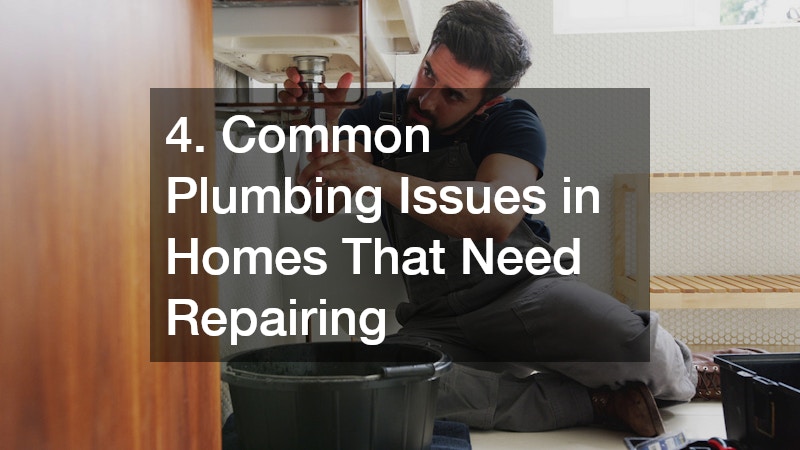Beginner Tips for When Your Home Needs Repairing
Homeownership comes with the inevitable need for repairs. Whether it’s a leaky faucet or a creaky floorboard, knowing how to address these issues is vital for every homeowner. The overarching responsibility of maintaining a home can seem daunting for beginners unaccustomed to the nuances of home repair. Fortunately, this article sheds light on the essentials of tackling the common problems you may encounter. From identifying early warning signs to exploring DIY versus professional assistance, understanding these basics will empower you. Utilizing these troubleshooting tips and tools, you can effectively manage repairs to ensure your home remains a safe and comfortable sanctuary.
1. How to Identify Signs Your Home Needs Repairing

Identifying signs that your home needs repairing is the first step in maintaining its integrity and safety. One of the most common areas that requires attention is the roof. Over time, roofs are exposed to harsh weather and can deteriorate, making roof repair a common necessity. Signs of damage include missing shingles, water stains on the ceiling, and moss growing on the surface. Ignoring these signs can lead to more significant problems like leaks and structural damage.
Another area that often needs repairing is the foundation. Cracks in walls or floors, doors that don’t quite close properly, and uneven floors may indicate foundational issues. These issues can stem from varying factors such as water damage or poor construction. The sooner you identify and address these problems, the less costly they will be, and they will help avoid long-term structural damage.
An often-overlooked indicator is rising energy costs, which can be a sign that something in your home needs repairing. For example, a drafty home may mean that the windows and doors require sealing or replacement. Energy inefficiencies often suggest that HVAC systems require either maintenance or comprehensive ac repairs to function effectively.
2. DIY vs. Professional Help: When Your Home Needs Repairing
When your home needs repairing, deciding between DIY solutions and professional help can be challenging. For simple tasks like patching a small drywall hole or fixing a leaky faucet, DIY solutions are manageable and can save you money. These tasks often require minimal tools and are low risk, making them ideal for those who prefer handling issues independently.
However, when dealing with complex problems such as AC repairs or large plumbing issues, it is advisable to seek professional assistance. These systems can be intricate, and mishandling them may lead to further damage or safety hazards. Hiring a licensed professional ensures that repairs are effected correctly, safeguarding you from potential disasters.
Additionally, assessing the time and tools available is crucial. While simple tasks can be a weekend project, those that require specialized equipment or extended time might be better suited for professionals. The risk and cost of incorrect execution can outweigh the savings from DIY attempts, emphasizing the importance of knowing when expert intervention is necessary.
3. Essential Tools for Beginners When Home Needs Repairing
Equipping yourself with essential tools is crucial when your home needs repairing. A basic toolkit should include a hammer, screwdrivers, pliers, and a tape measure. For those venturing into more specific tasks, a wrench set, a utility knife, and a stud finder are also valuable additions. These tools can handle a wide variety of fixes, from assembling furniture to minor plumbing repairs.
A reliable ladder is another fundamental item, particularly for tasks related to roof repair or gutter cleaning. Safety is paramount, so investing in a sturdy and appropriately sized ladder can prevent accidents. Pair this with a good-quality tool belt to keep your hands free and tools accessible while working on elevated projects.
A visit to your local carpet store may also yield valuable supplies that extend beyond flooring needs. Many stores carry protective gear, adhesives, and repair kits that are essential for various repairs around the house. Having these items on hand ensures you are prepared to tackle any minor issues as they arise, efficiently maintaining your home’s condition.
4. Common Plumbing Issues in Homes That Need Repairing

Plumbing issues are common in homes and often require immediate attention when they arise. Dripping faucets, for instance, are not only annoying but can also significantly increase your water bill over time. Taking apart a faucet and replacing a washer is a simple fix that can resolve this issue, but when ignored, it may lead to more severe plumbing problems.
Clogged drains and toilets are another prevalent issue that needs repairing promptly. These issues are often due to an accumulation of debris or improper flushing substances that block the pipes. Utilizing a plunger can often resolve minor clogs, but persistent problems might necessitate calling a professional plumber to assess the situation thoroughly.
Leaking pipes can be particularly insidious, as they often go unnoticed until water damage becomes apparent. Signs such as damp walls, low water pressure, or strange noises in the plumbing system indicate potential leaks that need prompt attention. Tile roofers can sometimes help in cases where such leaks originate from the roof, ensuring a comprehensive resolution to water ingress issues.
5. Addressing Electrical Problems When Your Home Needs Repairing
Electrical problems in a home can be hazardous and should be approached with caution when they need repairing. Flickering lights, frequently tripped circuit breakers, or outlets that do not work are common indicators of electrical issues. Addressing these issues promptly is critical to prevent potential fires and ensure a safe living environment.
A fundamental repair that can be done by handy individuals is replacing old or faulty light fixtures and switches. When executed carefully, such replacements can improve both function and aesthetic without requiring extensive electrical knowledge. Nevertheless, it is vital to always shut off the power at the circuit breaker before performing any electrical repairs.
For more complex tasks, such as rewiring or fixing an iron window that hinges with electrical components, seeking a professional electrician’s help is advisable. Licensed electricians can safely and correctly diagnose issues that a novice may overlook, offering peace of mind and ensuring home safety. Regular inspections and upgrades are also recommended to keep your home’s electrical system up to date.
6. Dealing with Structural Issues in a Home That Needs Repairing
Structural issues within a home require a keen eye and often significant interventions when they need repairing. Common signs of structural problems include cracks in the walls or ceilings, sagging floors, and doors that no longer align with their frames. These problems can often be symptoms of larger issues, such as settling foundations or water damage.
It is crucial to address such problems quickly to prevent exacerbating damage, which could lead to costly repairs or even pose safety risks. In some cases, local hardscaping service providers may offer solutions for addressing foundation concerns, especially if grading or drainage is contributing to the issue.
When structural problems are suspected, consulting with a structural engineer or experienced contractor is advisable. They can conduct a thorough inspection and deliver a detailed report on necessary repairs and preventative measures. This approach ensures solutions are tailored to the specific needs of your home, preserving its long-term structural integrity.
7. Roof Repair Tips for a Home That Needs Attention

Roof repair is crucial for maintaining a home, particularly since leaks or damage can lead to extensive internal problems. Regular inspections can help identify issues early, saving both time and money in the long term. Common roof issues include missing or damaged shingles, clogged gutters, and leaks around chimneys or skylights.
For minor roof repairs, such as replacing a few shingles or cleaning gutters, safety is paramount. Using a secure ladder, wear proper shoes and consider a harness if working on steep or high locations. These repairs can often be completed without professional assistance, though regular monitoring is encouraged.
In cases where large areas of the roof need attention or replacement, it is beneficial to contact an asphalt paving contractor or roofing professional. These experts can assess overall roof condition and recommend comprehensive solutions tailored to your home. This professional insight helps ensure that your roof continues to protect and insulate your home properly.
8. When Your HVAC System Needs Repairing
The HVAC system within a home is crucial for creating comfortable living conditions, especially during extreme weather when it inevitably needs repairing. Signs that your system needs servicing include uneven heating or cooling, strange noises, or increased utility bills. Regular maintenance can help identify these issues before they escalate.
While some homeowners may be inclined to handle minor HVAC repairs themselves, such as replacing filters or cleaning vents, complex issues should be left to experts. Faulty handling may lead to more significant damage or even void warranty agreements, emphasizing the importance of professional service. Hiring kitchen remodelers with an HVAC specialty can ensure thorough and safe repairs or replacements.
Scheduling regular inspections from a certified technician can prolong the life of your HVAC system and maintain optimal efficiency. These inspections can preemptively address potential problems, ensuring your system remains reliable. Timely interventions also help homeowners avoid unexpected expenses, providing peace of mind year-round.
9. Repairing Interior Finishes in Your Home
Interior finishes, such as walls, floors, and ceilings, often require attention and repairs to keep a home looking its best. Common issues include scuffed walls, cracked tiles, or scratched wooden surfaces, all of which can be repaired with the right materials and techniques. A home remodeling service can help restore these finishes, enhancing your home’s aesthetics.
Tiles, for instance, might crack due to movement, impact, or improper installation. Tile roofers can replace or repair damaged tiles with minimal disruption, maintaining the seamless finish of your surfaces. Prompt repair of these issues prevents further degradation and often simplifies the restoration process.
In addition to structural finishes, decorative elements like crown molding, wainscoting, or unique iron window frames may also require attention to maintain a cohesive style throughout your home. Repairing or refinishing these elements can refresh interior spaces, reflecting personal taste and adding value to your property.
10. Landscape and Outdoor Repairs

Outdoor spaces are extensions of your home, requiring regular maintenance and occasional repairs when they need attention. Common tasks include repairing fences, mending patios, or adjusting drainage systems to prevent erosion. Regular upkeep of these areas is essential for preserving outdoor aesthetics and functionality.
For trees and shrubs that potentially endanger property or block views, hiring a tree trimming service is advisable. Professional services ensure healthy growth and proper removal, protecting both property and landscaping. Expertise in tree care can prevent untimely plant death, ultimately saving time and resources.
In addition to vegetation management, addressing hardscaping issues such as cracked paths or sagging deck boards is vital. Local hardscaping services can repair or replace materials to enhance outdoor aesthetics and safety. These interventions help sustain a welcoming and practical outdoor space through all seasons.
Incorporating These Tips When Your Home Needs Repairing
Tackling home repairs can be daunting, but with these beginner tips, you can efficiently assess and address common issues. Understanding the red flags and having the essential tools enables you to navigate basic repairs with confidence. Moreover, knowing when to call in professional help can prevent costly mistakes and ensure quality outcomes. Whether you’re repairing a leaky faucet or maintaining your HVAC system, having an informed approach increases your home’s value and comfort. Engaging in regular inspections and maintenance ultimately upholds your investment, providing peace of mind and enhancing your living environment. Remember, proactive and informed home repairs make all the difference in ensuring longevity and safety for your loved ones.
By gradually building your skill set, you’ll feel more empowered to tackle increasingly complex tasks without hesitation. Start with small projects, like patching drywall or fixing a running toilet, to grow your confidence before progressing to more involved repairs. Keep in mind that every repair, no matter how minor, offers a valuable learning opportunity. You might even discover that taking care of your home becomes a satisfying and rewarding experience over time. Always document the repairs you complete—this habit not only helps with future troubleshooting but also demonstrates conscientious homeownership when it comes time to sell. Finally, continue educating yourself with trusted resources, whether that’s through DIY guides, local workshops, or professional consultations.
